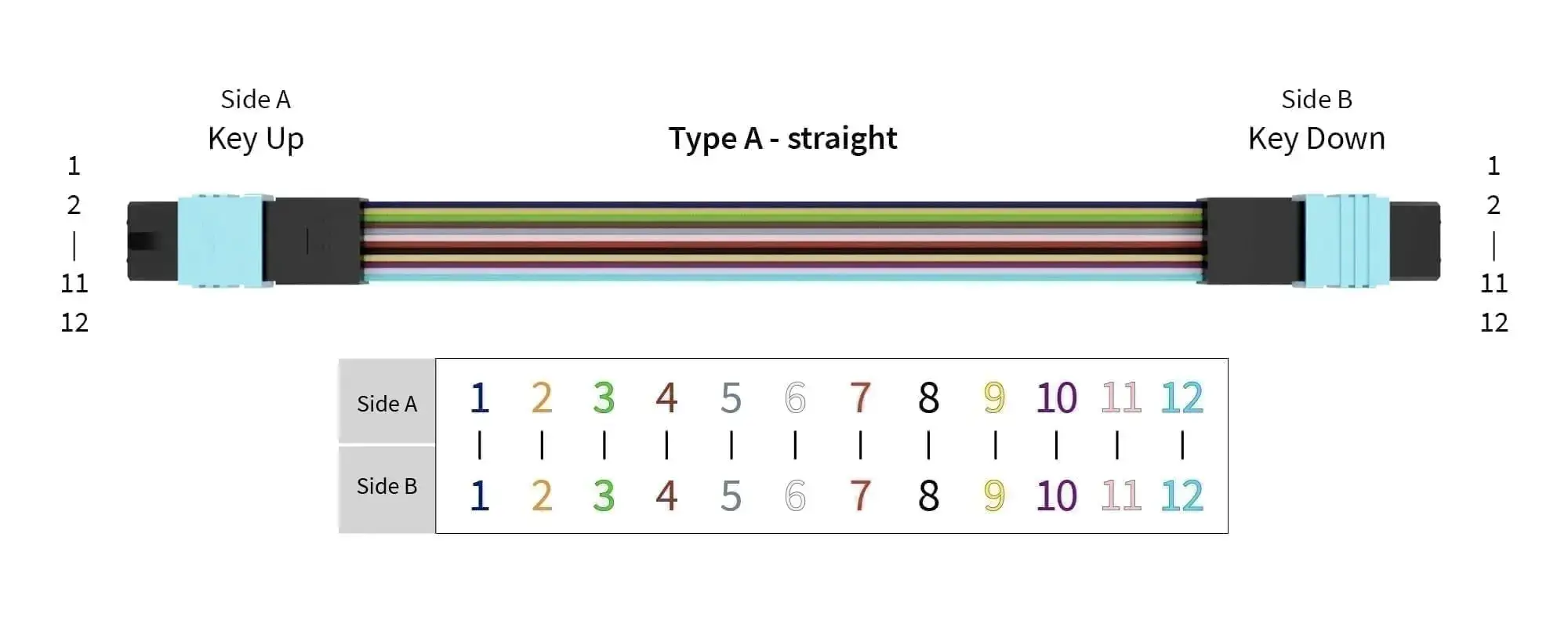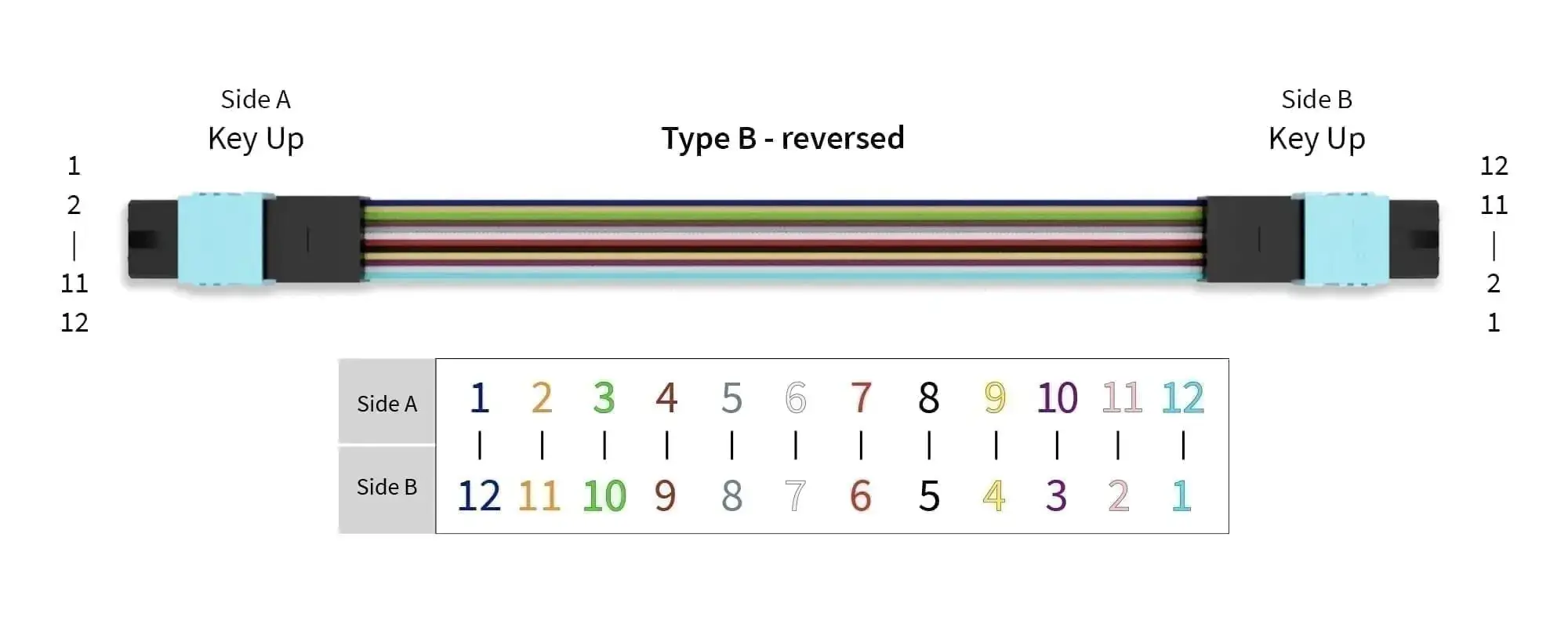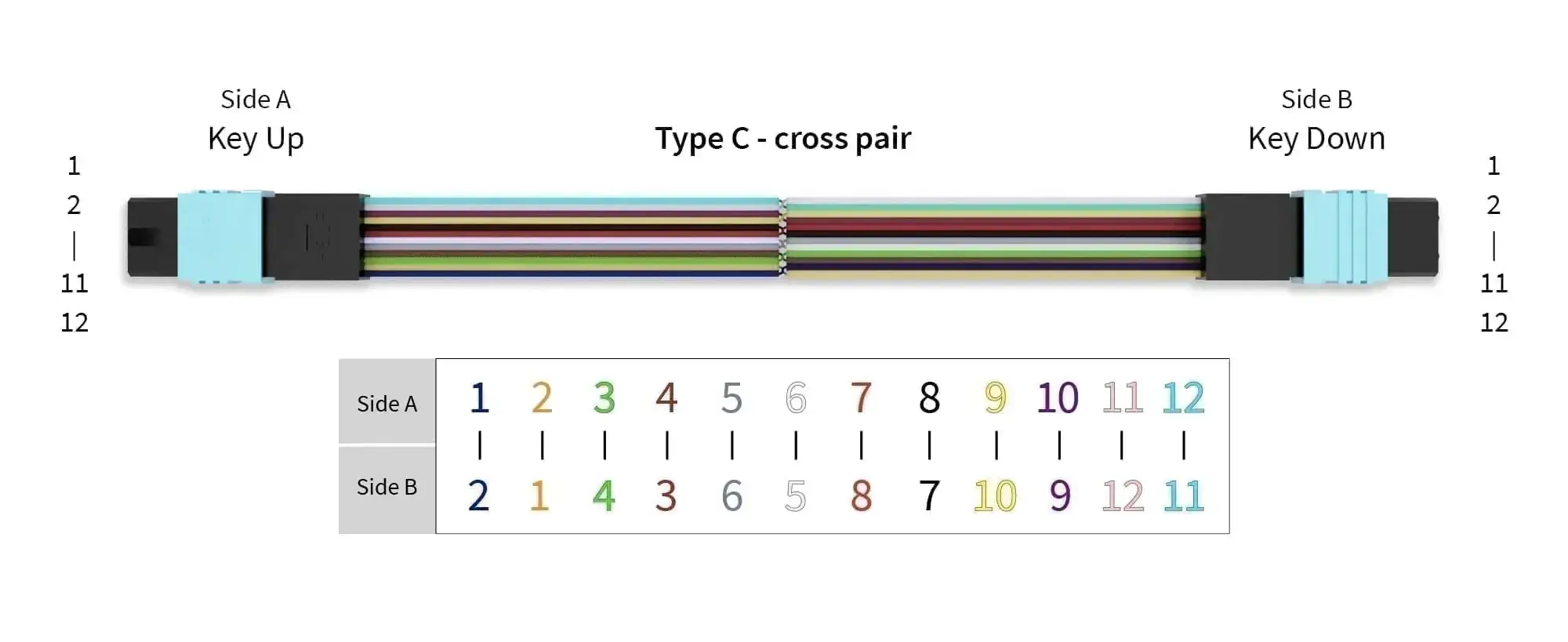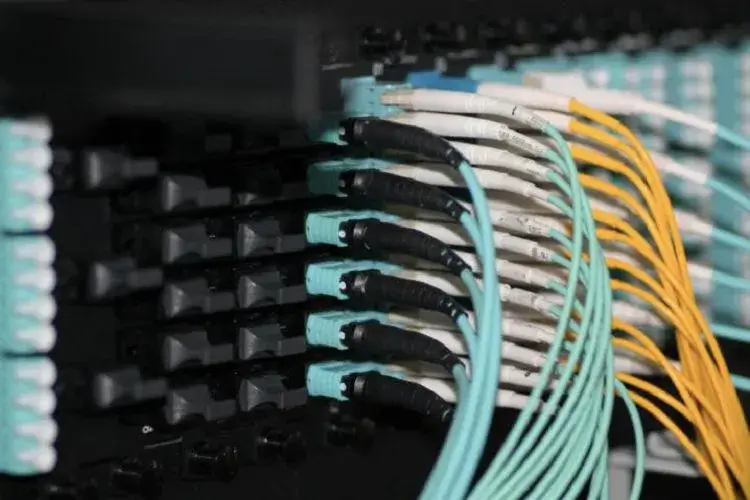In the dynamic landscape of data centers, the challenges posed by expanding bandwidths and intricate network connections are ever-present. The once reliable conventional LC cables, designed for dual-fiber patching, now find themselves inadequate for the task at hand. Enter the solution: MTP/MPO cables, revolutionizing the field by accommodating multiple fibers within a single multi-fiber MTP/MPO connector. This innovation has paved the way for pragmatic answers to the high-density cabling demands of 40G, 100G, 400G, and even 800G within data centers. The forthcoming sections of this article will delve into the myriad benefits, diverse variations, and wide-ranging applications of MTP/MPO cables.
What Are MTP MPO Cables?
MPO (Multi-Fiber Push On) cables are terminated with MPO connectors at both ends, strategically designed to offer a single connector solution for multi-fiber connectivity. These connectors cater to the demands of high bandwidth and high-density cabling systems. In accordance with standards such as IEC 61754-7 and U.S. TIA-604-5, the MPO connector has established its compliance. Currently, MPO connectors are readily accessible with fiber counts of 8, 12, 16, or 24, catering to common applications in data centers and local area networks. For more specialized scenarios, larger fiber counts such as 32, 48, 60, and 72 are attainable, especially in expansive optical switches that require super high-density multi-fiber arrays.
On the other hand, MTP cables, an abbreviation for (Multi-Fiber Pull Off), come fitted with MTP fiber connectors at each termination point. The MTP connector, a trademark of US Conec, represents an enhanced version of the MPO connector, featuring improved specifications. MTP connectors align harmoniously with generic MPO connectors, enabling seamless interconnection with other MPO-based infrastructures. Notably, the MTP connector stands as a meticulously engineered product advancement, engineered to elevate both mechanical and optical performance in comparison to standard MPO connectors.
MTP vs MPO Cables: What Are the Differences?
MTP and MPO stand out as popular choices for organizing fiber cabling. While they can often be swapped, they aren’t exactly identical. The simplest way to put it is that MTP is an improved, branded version of MPO. The MTP connector, developed by US CONEC, features a detachable casing. This casing lets you polish, fix, or switch the connector heads. Moreover, it’s designed with a more advanced mechanical support system that’s notably more durable.
When it comes to how well they send data, MTP and MPO are incredibly similar, which is why they’re used interchangeably. Both can handle 400G data transmission. More importantly, they adhere to the same standards for their pre-made cables. This means that most MTP and MPO cables can be set up in tight spaces, handling more data with less effort from the installation team. Both options offer outstanding performance and often result in significant returns on investment when put into action.
MTP MPO Cabling Solutions Benefits
MPO/MTP solutions prove optimal for high-performance networks requiring elevated data rates. Through MPO/MTP cabling, data centers can attain dense fiber setups and facilitate swifter speeds without the intricacies and uncertainties of on-site splicing. These solutions demand notably less cabling, simplifying cable management within racks, expediting installation, and simultaneously minimizing cable interference with cooling systems. Being modular, this system permits rapid and uncomplicated capacity expansion in line with evolving data center needs. Undoubtedly, this straightforward approach translates to long-term cost savings.
MTP/MPO Cable Types
Different kinds of MTP/MPO cables are categorized based on their functions, polarity, fiber count, fiber mode, and jacket rating. A range of MTP/MPO cables is accessible to cater to diverse application settings and specific needs.
By Function
There are three primary types of MTP/MPO cables, each catering to high-density cabling networks, offering enhanced network capacity and flexibility.
- MTP/MPO Trunk Cables
These cables have MTP/MPO connectors (female/male) on both ends and are available in fiber counts ranging from 8 to 144, providing users with a variety of options. MTP/MPO trunk cables are commonly used in structured cabling systems for backbone and horizontal interconnections. They are suitable for establishing direct connections like 40G-40G and 100G-100G.

- MTP/MPO Breakout Cables
Also known as harness cables or fanout cables, these cables have a female/male MTP/MPO connector on one end and 4/6/8/12 duplex LC/FC/SC/ST connectors on the other end. Examples include 8-fiber MTP/MPO to 4 LC harness cables and 12-fiber MTP/MPO to 6 LC harness cables. These cables are typically used for short-range connections like 10G-40G and 25G-100G, or for linking backbone assemblies to rack systems in high-density backbone cabling scenarios.

- MTP/MPO Conversion Cables
MTP/MPO conversion cables share a fanout design with breakout cables but differ in terms of fiber counts and types. These cables have MTP/MPO connectors on both ends. Common variants include 24-fiber to 2×12-fiber, 24-fiber to 3×8-fiber, and 2×12-fiber to 3×8-fiber MTP/MPO conversion cables. They are particularly well-suited for connections like 10G-40G, 40G-40G, 40G-100G, and 40G-120G. These cables eliminate fiber wastage and significantly enhance the flexibility of MTP/MPO cabling systems.

By Polarity
MTP/MPO cable types categorized by polarity address the distinction between the optical transmitters and receivers at both ends of the fiber link. The unique design of MTP/MPO connectors necessitates the consideration of polarity in high-density MTP/MPO cabling systems.
The TIA 568 standard outlines three connection methods—Type A, Type B, and Type C—to ensure accurate polarity of the optical path. These methods correspond to the diverse structures of cables associated with the three types of MTP/MPO connectors. Furthermore, the introduction of ANSI/TIA-568.3-E has introduced two novel universal polarity methods: U1 and U2. These methods have the potential to streamline fiber cabling installations and maintenance processes.



By Fiber Count
MTP/MPO cable variants featuring different core counts are categorized into 8/12/24 cores, commonly applied for 40G/100G connections. The most recent addition, the 16-fiber cables, is tailored for short-distance 400G cabling within hyperscale data centers.

- 8-fiber MTP/MPO cables: The 8-fiber MTP/MPO cables can achieve equivalent data rates as 12-fiber cables while maintaining lower costs and insertion losses, thus presenting a more economical choice.
- 12-fiber MTP/MPO cables: 12-fiber MTP/MPO cables were among the earliest developments and remain the most prevalent solution for 10G-40G and 40G-100G connections. However, using them with 40G QSFP+ or 100G QSFP28 transceivers results in 4 idle fibers, leading to suboptimal fiber utilization.
- 24-fiber MTP/MPO cables: 24-fiber MTP/MPO cables are typically deployed to establish a 100GBASE-SR10 link between CFP-to-CFP transceivers.
- 16-fiber MTP/MPO cables: In contrast, 16-fiber MTP/MPO cables share the same external footprint as traditional 12-fiber MT (mechanically transferable) ferrules. They aggregate multiple 8-fiber parallel transceivers and directly couple to emerging 16-fiber parallel fiber links, such as 400G QSFP-DD and OSFP, facilitating advanced connectivity solutions.
By Fiber Mode
MTP/MPO cable types are differentiated by their fiber modes, encompassing multimode variants like OM3/OM4/OM5, as well as single-mode OS2 cables. Multimode MTP/MPO cables, classified as OM3/OM4/OM5, are tailored for shorter distances. They support maximum transmission distances of 300m/400m/440m respectively (when paired with corresponding modules) and are suitable for scenarios such as 40 Gigabit per second transmission.
Conversely, single-mode MTP/MPO cables, specifically OS2, are designed for long-distance transmissions. These cables are applicable in contexts like Metropolitan Area Networks (MANs) and Passive Optical Networks (PONs). With reduced modal dispersion, OS2 offers higher bandwidth compared to OM3/OM4/OM5. The achievable maximum transmission distances for MTP cables are outlined below. It’s crucial to note that these distances are contingent upon using the appropriate modules to attain the specified transmission capabilities. For instance, a single-mode MTP-12 trunk necessitates pairing with a 40G QSFP-PLR4-40G module to achieve a 10km transmission range.

By Jacket Rating
MTP/MPO cable types are categorized based on various fire rating requirements, resulting in jacket options like LSZH (Low Smoke Zero Halogen), OFNP (Optical Fiber Nonconductive, Plenum), and CMP (Communications Multipurpose Cable, Plenum).
- LSZH MTP/MPO Cables
These cables are devoid of halogenated materials, which can release toxic and corrosive substances when burned. LSZH cables offer enhanced protection for both personnel and equipment in the event of a fire. They are particularly fitting for enclosed spaces. - OFNP MTP/MPO Cables
Designed without electrically conductive elements, OFNP cables hold the highest fire rating. This quality allows them to be safely installed in areas such as ducts and plenums, which accommodate the building’s airflow systems. - CMP MTP/MPO Cables
CMP cables are engineered to control flame propagation and regulate smoke exhaust rates during a fire incident. These attributes make them well-suited for plenum spaces, where the circulation of air supports heating and air conditioning systems.
Use and Future of MTP and MPO Cables in Data Centers
The utilization and future prospects of MTP and MPO cables within data centers are noteworthy. Pre-terminated cables significantly reduce labor hours during installation. In environments where data centers are in a constant state of scaling up transmission speeds and capacity, MTP and MPO cables emerge as the optimal solution. The efficiency gains achieved through expedited installations lead to substantial cost savings, and often provide the best return on investment.
This efficiency-driven trajectory propels the promising trajectory of MTP connectors. Already gaining prominence in 400G and other high-speed fiber applications, their prevalence is set to grow. As these high speeds become more widespread and accessible, the simplified installation and design attributes of MTP cabling will play a pivotal role. These cables will extend the reach of high-speed fiber to a greater number of locations worldwide, spearheading the ongoing global expansion of high-speed data connections. It’s the unique capabilities that these cables bring that will facilitate broader access to data center speeds across a diverse array of applications.
Conclusion
The various features that differentiate MTP/MPO cable types simplify the process of selecting the optimal network connection solution tailored to specific requirements. MTP/MPO cables have gained significant popularity for high-density cabling within data centers. Their ability to house multiple fibers within a single interface greatly enhances network capacity, maximizes space efficiency, and streamlines cable management.




